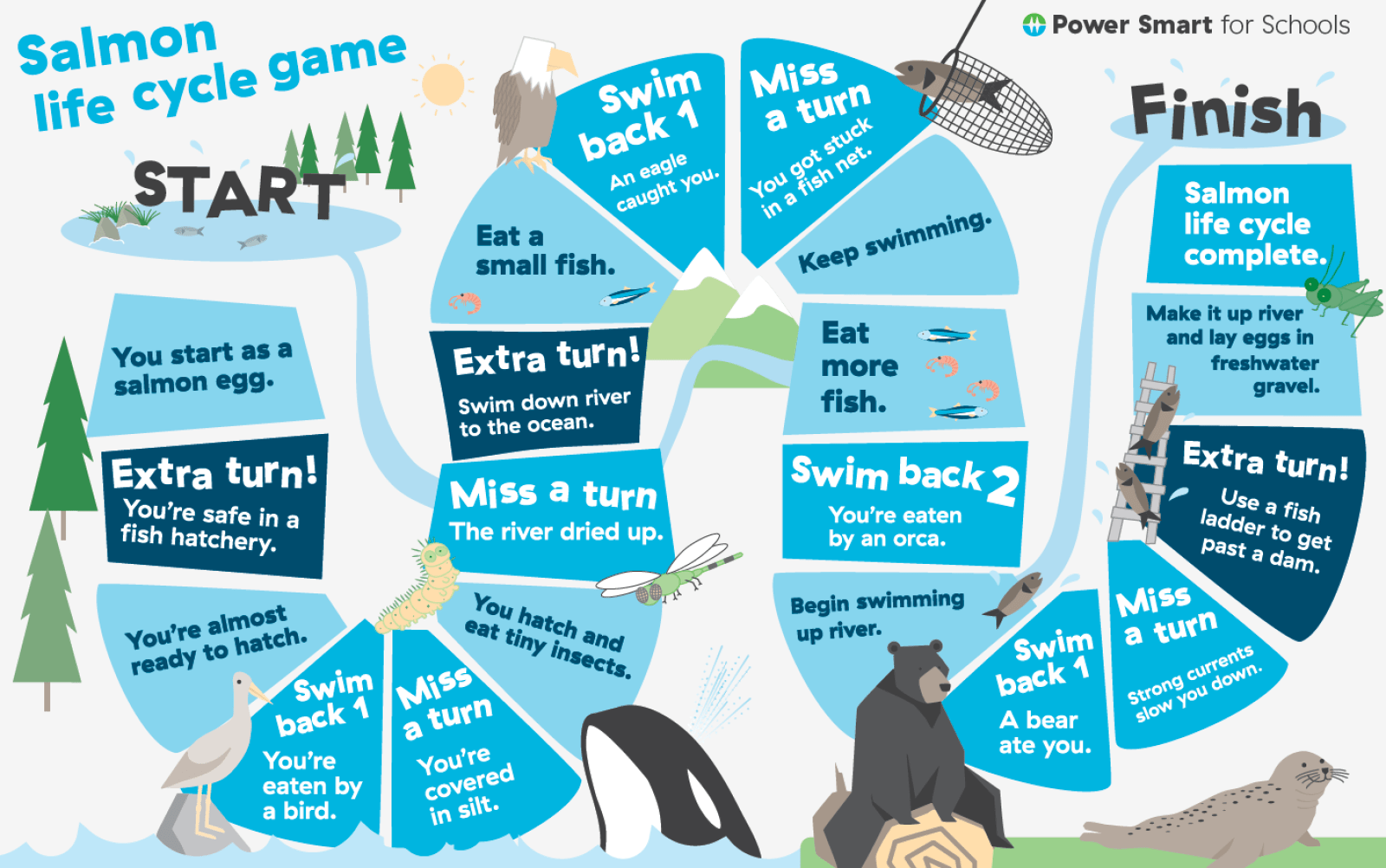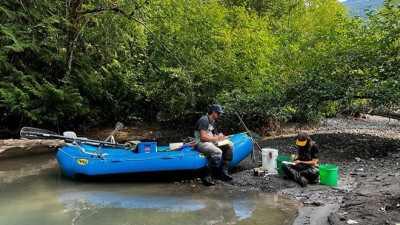Salmon life cycle game
The Salmon life cycle board game takes us on a salmon’s journey from the river to the ocean and back again.

Overview
Roll the dice to follow a salmon’s path from the river out the ocean and back upstream with this printable board game. Along the way, we learn how other living things are connected to salmon and the role we play in caring for our resources.
Instructions
What you'll need
- Dice – 1 per group
- Small objects for player tokens – 1 per student
- "Salmon life cycle game board" – 1 per pair or small group
- Print in landscape 11" x 17" paper for a big game board or print to fit 8.5" x 11" standard paper for a smaller game board
- Start with a review of life cycles and animal needs before playing the game:
- Animals have a life cycle that includes being born, growing into an adult and eventually dying.
- All animals need basic things to survive including water, food and shelter.
- This game's all about salmon, so let’s brainstorm what we know about salmon and share ideas.
- Get students into pairs or small groups with a copy of the board game and review the vocabulary:
- Egg
- Fresh water
- Salt water
- Ocean
- Hatch
- Adults
- Salmon
- River
- Eat
- Food
- Explain how the game works and it’s time to play.
- Regroup in a circle and talk about what we learned during the game:
- What different water sources are used by salmon?
- What other living things connect to salmon in the game?
- What did humans do in the game to help salmon?
- How did humans make life more difficult for the salmon?
- What questions do we have about salmon, living things and their connection to water?
- Explain Indigenous connections to the land and water and their view that all living things, including humans, are interconnected. All living things are important to life on Earth and we have a responsibility to care for the environment and act as stewards, or caretakers, of Earth’s resources.
- The game shows how living things depend on water and are connected.
- It’s important for us to help take care of living things, resources and our environment.
Modify or extend this activity
- Have students make word cards with the vocabulary from the game board. Have them read, spell and alphabetize the words.
- Have students draw a picture of the life cycle of a salmon, including the challenges they face and the different water sources involved.
- Students write or draw ways they use water in a day, including how it’s used at home and at school (for drinking, growing food, cooking, cleaning, electricity, etc.).
- Explore how humans connect to the natural world, animals and life cycles through stories. Consider some of the following options:
- From the Mountains to the Sea: We Live Here, From the Mountains to the Sea: We Share the Seasons and From the Mountains to the Sea: We are the Community. Terri Mack and Brenda Boreham (2015)
- Sharing Our World: Animals of the Native Northwest Coast (2010)
- Dancing with the Cranes. Jeannette Armstrong (2009)
Curriculum Fit
Grade 2 Science
Content
- Water sources including local watersheds
- Water conservation
- Local First Nations knowledge of water
- Life cycles of different organisms
Curricular competencies
Questioning and predicting
- Demonstrate curiosity and a sense of wonder about the world
- Ask questions about familiar objects and events
Evaluating
- Consider some environmental consequences of their actions
Applying and innovating
- Transfer and apply learning to new situations
Grade 2 Socials Studies
Content
- Rights and responsibilities of individuals
Curricular competencies
- Ask questions; gather, interpret and analyze ideas; and communicate findings and decisions
- Recognize the causes and consequences of events, decisions or developments
Assessments
- Assess students’ ability to work together in small groups.
- Assess students’ participation in class discussions.
Teaching Notes
Board game instructions
- Print enough copies of the "Salmon life cycle game board" so students can play in pairs or small groups.
- Students will need to read as part of the game. Pair confident readers with developing readers, play the game when you have additional help in the class or use it with an older buddy class.
- Rules of the game:
- Students play the role of a salmon as they move from Start to Finish.
- Each player places their token on the Start position.
- Players take turns rolling the dice and move their token around the board.
- Some spaces on the board have instructions to follow like “Miss a turn”, “Swim forward 2”, “Swim back 1” or “Extra turn”.
- The first player to reach the finish wins, or play until everyone finishes.
Indigenous perspectives
Indigenous Peoples depend on their knowledge of place that has evolved from generations of observations about how plants and animals respond to seasonal patterns. The land provides Indigenous Peoples with food, water, shelter, clothing and tools, as well as a spiritual connection, stories and traditions.
Indigenous Peoples have long recognized the interconnectedness of all living things on Earth. The concept of interconnectedness, and that humans are just one strand in the web of life, may help students to understand the importance of caring for the environment and acting as stewards, or caretakers, of Earth’s resources.
Salmon life cycle
Egg: Eggs are laid in rivers by the female in a nest (known as a redd) and then one or more males fertilize the eggs.
Alevin: When the eggs hatch in late winter, the tiny fish are called alevin. Alevin have a nutritious yolk sac attached to their bellies that they feed on for up to four months.
Fry: Once they have finished their yolk sac and leave the gravel, they start to feed on live prey. They may head straight to the ocean or stay in the river for another year.
Smolt: As salmon swim to the ocean, their bodies go through major physiological changes, called smolting. In the estuaries, where rivers meet the ocean, their bodies adjust and adapt to living in salt water.
Adult: Salmon become adults when they reach the ocean and live there for one to seven years.
Spawner: When they begin the journey back to the river where they hatch to lay or fertilize eggs, they are called a spawner.







